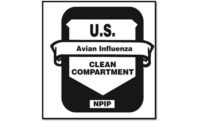Antibiotic usage in animals produced for food has been a controversial topic for the past several years. The concern has been centered on the concept that antibiotic use in food animals may induce antibiotic resistance in potential food-borne pathogens for humans. Although this concept has been difficult to substantiate with hard data, consumer concerns have driven regulatory agencies, food retailers and poultry producers to make changes in antibiotic usage.
The Food and Drug Administration (FDA) provided the food animal industries guidance documents that created a framework for how antibiotics would be used in food animals beginning in 2017. This information was provided three years in advance so the animal agriculture and pharmaceutical companies could make the necessary changes. The guidance documents specified which antibiotic types were critical to human medicine and declared these medically important antibiotics would be used for therapeutic purposes and not for any production purposes. Further, it was specified that antibiotic usage would be allowed only with veterinary supervision.
During the same time period, various food retailers and restaurant chains released statements of their intent to sell only poultry products from chickens and turkeys that had never been treated with antibiotics. These pledges created a market for what is now called No Antibiotics Ever (NAE) poultry products, and many poultry companies began to produce products for this new market well in advance of the FDA timeline. So, by the beginning of 2017, poultry companies had already adapted to the new antibiotic usage requirements and many were restricting antibiotic usage beyond requirements provided by FDA.
In order to capture all of the information documenting this massive shift in antibiotic usage in the U.S. poultry industry, the U.S. Poultry & Egg Association supported the efforts of Dr. Randall Singer, Mindwalk Consulting Group, to tabulate and analyze all of the antibiotic usage data from the broiler and turkey industries. This information was provided to Dr. Singer voluntarily by the poultry companies. The USDA’s Animal and Plant Health Inspection Service (APHIS) provided assistance in designing the survey instruments that facilitated the efforts of the poultry companies to supply data. FDA provided significant additional funding which allowed detailed analysis of the data. The National Chicken Council and the National Turkey Federation both facilitated the efforts of poultry companies to supply the raw data. The first edition of the report on the antibiotic usage in the poultry industry was released in early August and covered antibiotic usage 2013 through 2017.
The report shows the poultry industry use of medically important antibiotics declined dramatically and that there was a significant shift to the use of non-medically important antibiotics. The report clearly shows that the new FDA regulations had the intended effect on antibiotic use, which was to improve antibiotic use stewardship. Going forward, there will be an annual report of antibiotic usage by the poultry industry that will include the broiler, turkey, and the commercial egg layer industries. The full report can be viewed at http://www.uspoultry.org/poultry-antimicrobial-use-report/index.cfm NP



Report Abusive Comment